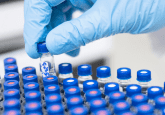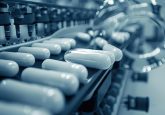Interview with Mike Oliver on sample preparation method optimization for increased efficiency in bioanalytical workflows
 Mike Oliver has held the position of Global Product Manager for sample preparation at Thermo Fisher Scientific since 2010, being responsible for the development and introduction of new innovative technologies such as SOLA™ to the market place. Prior to this role, Mike has worked for two leading MS vendors over a 9‑year period, being responsible for biotechnology sales within the UK and providing application solutions for proteomic and metabolic workflows based on high-resolution LC–MS platforms, respectively. Mike holds a PhD in MS and Biochemistry from the MS Research Unit, University of Wales, Swansea, UK.
Mike Oliver has held the position of Global Product Manager for sample preparation at Thermo Fisher Scientific since 2010, being responsible for the development and introduction of new innovative technologies such as SOLA™ to the market place. Prior to this role, Mike has worked for two leading MS vendors over a 9‑year period, being responsible for biotechnology sales within the UK and providing application solutions for proteomic and metabolic workflows based on high-resolution LC–MS platforms, respectively. Mike holds a PhD in MS and Biochemistry from the MS Research Unit, University of Wales, Swansea, UK.
In July, Mike presented a webinar for Bioanalysis Zone on ‘Sample preparation method optimization for increased efficiency in bio-analytical workflows’.
At what stage in your career did you first become involved in bioanalysis and what first attracted your attention to this area?
My career has always contained an element of bioanalysis from my PhD until my current role as Sample Preparation Product Manager at Thermo Fisher Scientific. For the last 3 years my focus has been to concentrate on the needs and challenges faced by the modern bioanalyst. It was at this time that Thermo Fisher Scientific began a number of in depth discussions with our bioanalytical customers as to what were the main barriers in their workflows and how these could be addressed.
Time and again issues were highlighted where sample preparation had a significant impact on the downstream analysis. These issues were primarily with the reproducibility of the assay and high sample failure rates, resulting in associated repeat analysis and reduced process speed. Other areas of concern highlighted were matrix effects and the impact of sample preparation devices on the quality and confidence of bioanalytical results and ultimately efficiency of the entire workflow.
We are always looking to develop new and innovative technologies that have a significant benefit to our customers, so based on these discussions we set out to develop a sample preparation product that could provide reproducibility and cleanliness of extract in a robust, quick and easy-to-use format.
As a consequence of this the Thermo ScientificTM SOLATM product range was born.
This first fritless SPE product range enables greater sample throughput by providing higher levels of reproducibility at low elution volumes while producing cleaner extracts and therefore delivering improvements in productivity. It is pleasing that our customers are seeing the benefits in their workflows which we set out to achieve when we first envisioned the product.
Please can you update us on some of the research activities in which your group is currently engaged?
In the short term, Thermo Fisher Scientific has expanded the selectivity options of the SOLA product range to provide weak cation and weak anion exchange mixed mode mechanisms which provide the bioanalyst with a comprehensive tool kit to enable analysis of previously challenging analytes e.g. extraction of strong acids or bases. These new mixed-mode phases have specific relevance to the biopharmaceutical field, where the analysis of large permanently charged molecules is often required.
Ultimately, our research and product development is driven by feedback from our customers. The demand for analysis of lower sample volumes from test animals or patients (for ethical or subject stress reasons) along with the move to higher efficacy drugs has resulted in lower limits of quantitiation for assays. With that in mind, in the future our sample preparation devices will need to deliver higher sensitivity with lower sample volumes combined with robust formats that can provide first-time success.
What can we expect from the webinar that you will be presenting on Bioanalysis Zone?
Sample preparation is a fundamental and vital stage of the bioanalytical workflow and a range of complimentary techniques are available.
The webinar will aim to address the considerations that need to be made when comparing the suitability of these techniques for use within bioanalytical methods. There will be a focus on achieving the desired levels of reproducibility and extract cleanliness whilst minimizing matrix effects and ensuring efficiency of the workflow. For example, protein crash is often an attractive proposition as it is relatively cheap and easy to implement; however, it can add significant time and cost to the overall workflow due to cross contamination, reduced column life time, more complex chromatography required to minimize matrix effects and increased repeat analysis rates due to poor reproducibility.
We will also look at method optimization and how the enhanced selectivities of our SPE range can be utilized to deliver sample extract cleanliness, minimize matrix effects and achieve improved productivity, particularly for previously difficult to analyze compounds.
In the next 5-10 years, what particular element of bioanalysis do you see advancing the most and why?
It is my opinion that LC-MS systems will continue to become more sensitive and high-resolution systems will push into the domain where triple quadrupoles were once prevalent. Obviously, one of the questions this will raise is “will there be less need for sample preparation or even no sample preparation requirement?”
We often forget the extremely complex nature of the biological samples that require analysis and the associated analytical challenges faced when quantitating and qualifying compounds. With that in mind I think that it is unlikely that LC-MS systems will provide the panacea to these issues in the next 5 years and I can only see sample preparation continuing to be a fundamental part of the overall process.
Sample preparation requirements will continue to be focused on ever-decreasing sample volumes combined with the need to increase detection sensitivity. It will be important to ensure that sample preparation development is in line with advances in instrumentation and chromatography to best meet the developing needs of the bioanalyst.
What words of encouragement would you give young scientists who might be envisioning a career in bioanalytical science?
It’s a fast-paced, exciting environment which continues to push the boundaries of scientific development, allowing you to meet new challenges each day and develop lateral thinking to explore different solutions to problems which ultimately will benefit mankind. It’s a great industry to be involved in with some of the most driven and intelligent minds in science. If you are willing to work hard and keep focused it can be a very rewarding career path.






